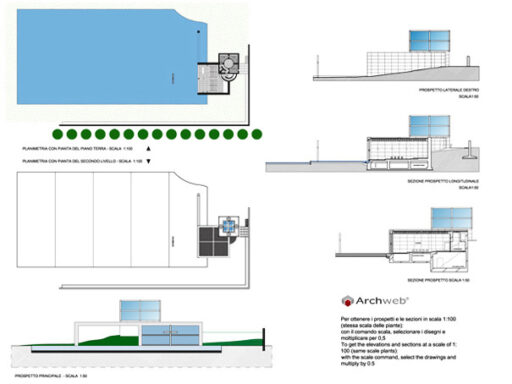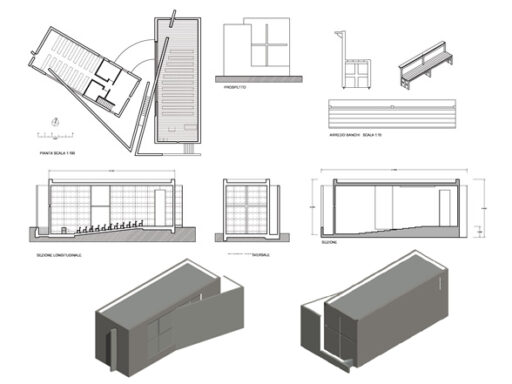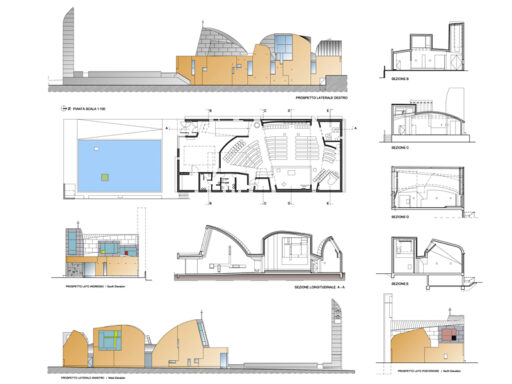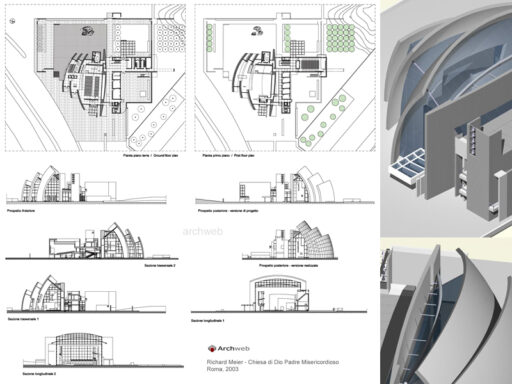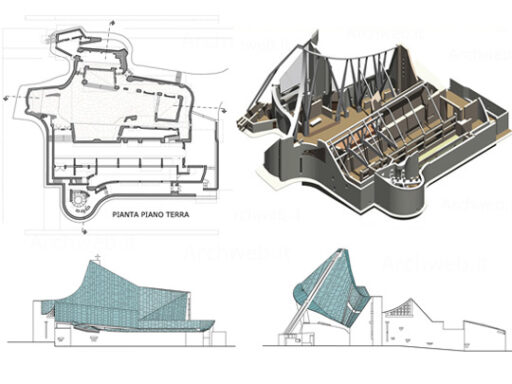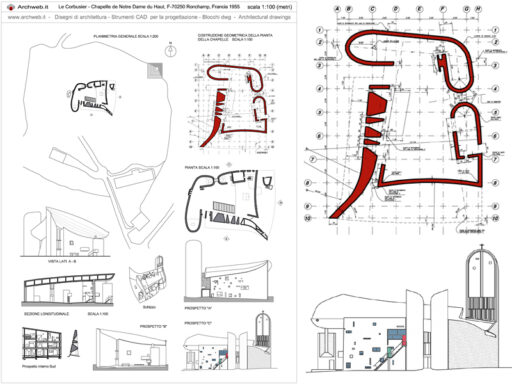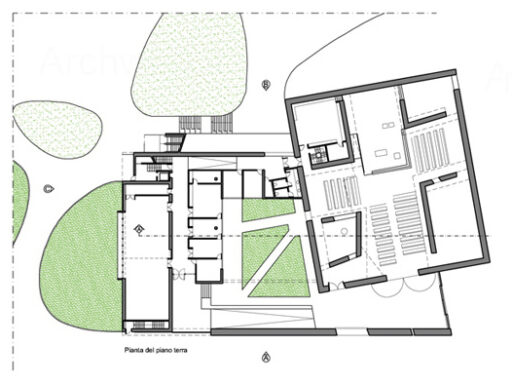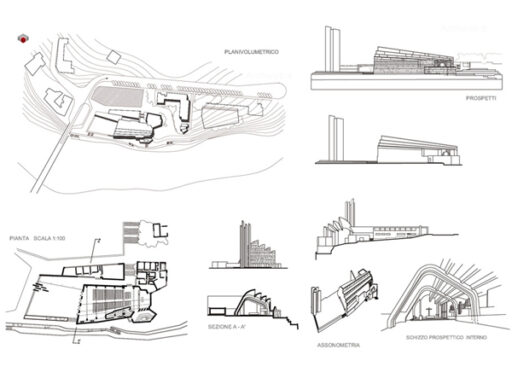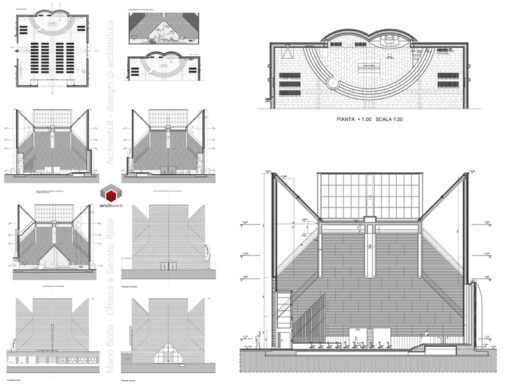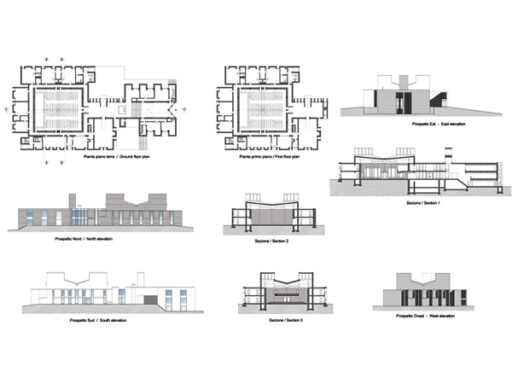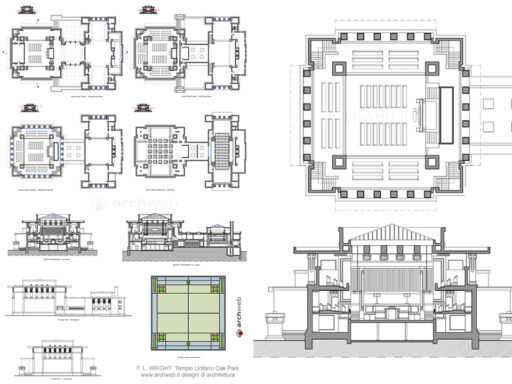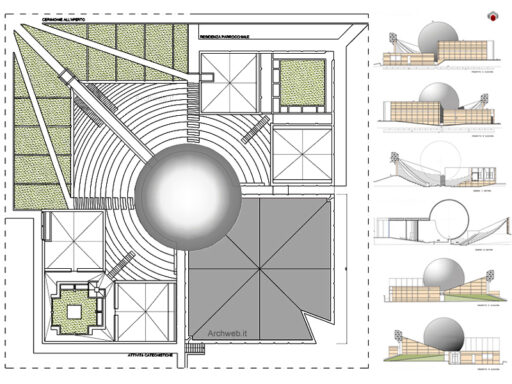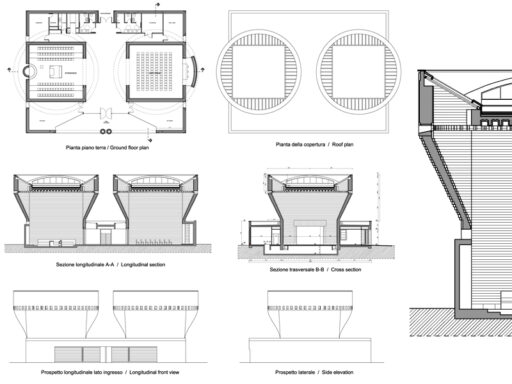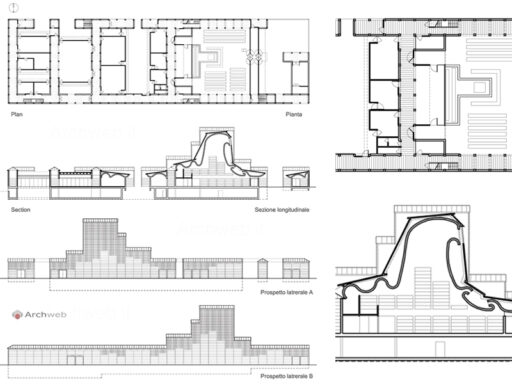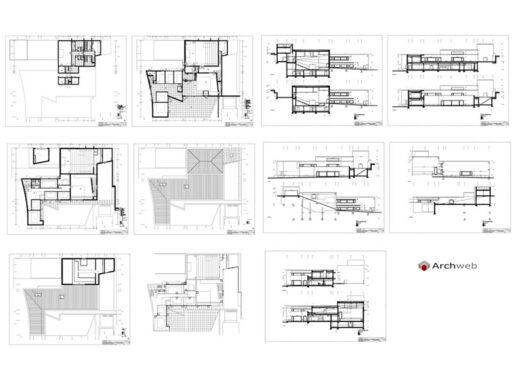Places of worship
Design between past and present
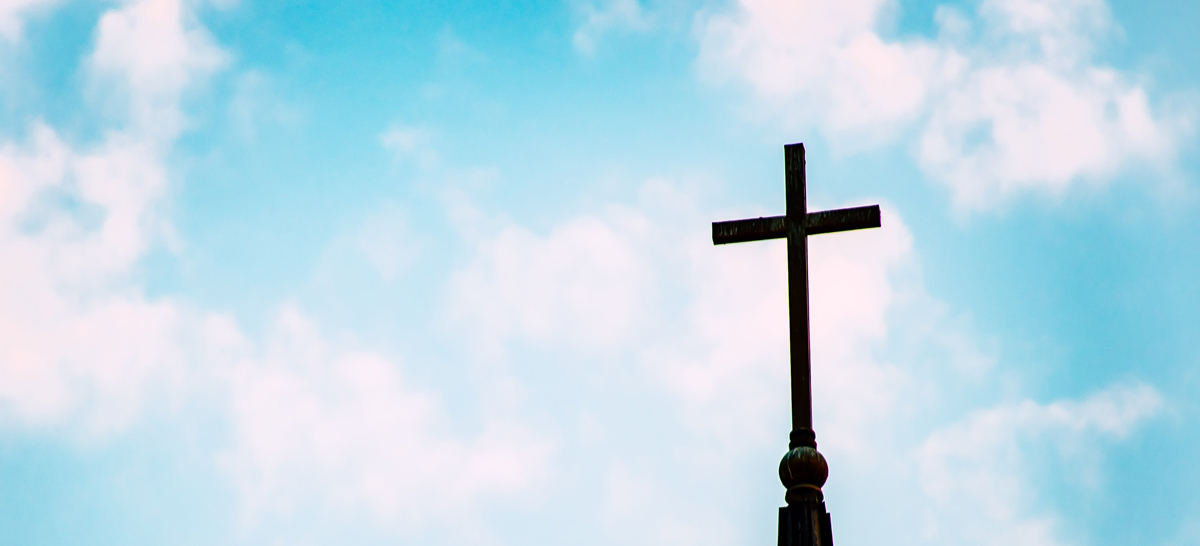
The sacred architecture sector has always proved to be complex but equally fascinating. In fact, the design of places of worship presupposes a particular sensitivity to the interpretation of symbols and images, an ability to masterfully link the sphere of the sacred to that of the profane. The sacred space has always been a place where the faithful make direct contact with the divinity and over the years it has also become a meeting and exchange point for the community belonging to a specific creed. Originally the temple, seen as the abode of the divinity, stood in the upper part of the settlement and often the faithful did not have free and complete access. Subsequently, real buildings were erected to the divinity, which had the peculiarity of being majestic and recognizable within the built environment. Just think of the Parthenon, an excellent work of classical architecture that has become a symbol of ancient Greece and of all religious buildings. With the passage of time and the spread of monotheisms, the evolution of these artifacts has seen them transform into places destined not only for prayer and religious ceremonies, but also for community life and activities designed for the faithful. It is from this moment that the religious places and the design of their environments determine an unexpected opening of the faithful to the divinity.
A brief excursus on the salient features of this interesting topic is presented below.
Sacred architecture and monotheistic cults
If we focus on the design of worship spaces, some elements of fundamental importance must be taken into consideration. From a functional point of view, it is good to know the rituals and celebratory practices of each religion, while as regards aesthetics, symbols and sacred images will determine the consistency and appearance of the artifact.
Analyzing the characters that influence the design of these places, the fact emerges that the three main monotheistic religions are united by some elements that find particular differentiations according to the specificity of the religious belief. For example, the distinction between spaces intended for faithful of different sexes is progressively more accentuated in Islamic rather than Christian worship. In fact, while in the latter case, only up to fifty years ago, the pews for women were on the left of the altar and those for men on the right, in the case of mosques still today there is a clear spatial distinction between the two sexes. Another substantial difference is represented by the presence or absence of a space for ablution of the body. This is a deeply felt practice in the Muslim tradition, a little less in the Jewish one and almost absent in the Catholic one except for the presence of the holy water stoup that is usually found at the entrance to churches.
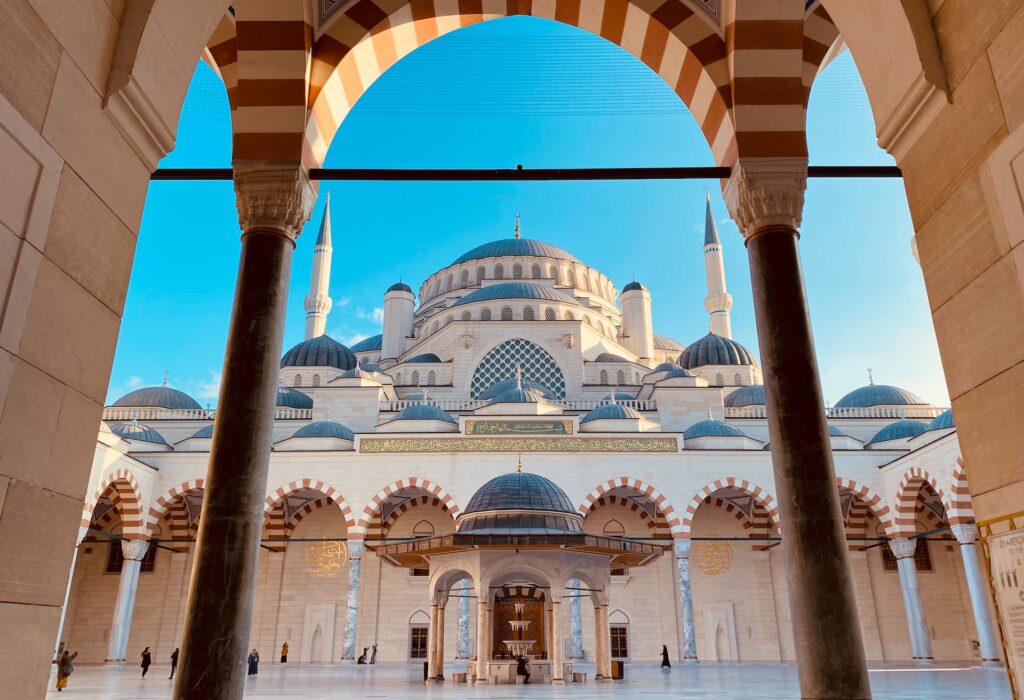
But now let’s see specifically what are the elements that characterize the main buildings of worship today.
CHRISTIAN CHURCH
The design activity of Christian churches evolves and develops over the centuries, keeping some elements firm and upsetting others. In the medieval period, the churches had a Latin cross layout where the nave met the transept and culminated with the area intended for the choir and apse. Over time, in the Renaissance period, the church became an emblem of geometry and symmetry and a symbol of papal magnificence. However, it is with the Baroque architecture that the sacred buildings reach the apex of splendor and richness, which can be found in the highly decorated and frescoed interiors. This trend towards decorative opulence undergoes a U-turn with the emergence of modern architecture which tends to simplify forms and eliminate all that is deemed superfluous. Furthermore, with the Second Vatican Council (1965) an important change took place regarding the participation of the faithful in the religious rite: unlike in the past, from this moment Christians are invited to actively participate in the ceremony.
In this way, the use of the spaces also changes as, for example, the presbytery, or the area once reserved for those who officiated mass, is now also accessible to the faithful. Taking part in the rite and gathering together increase the community value of the church which, from a building purely dedicated to worship, becomes a collective, symbolic and functional place. The path of the faithful marks the interior spaces that will be oriented towards the fulcrum of the celebrations starting from the atrium, through the nave, towards the altar, the central element and symbol of the entire religious community. The latter is an emblem, it must be accessible and visible to all and all the other spaces will be organized from it. Next to it is the ambo which constitutes the lectern and the area for the celebration of the rite. Usually on the opposite side of the altar is the baptismal font of variable dimensions, essential for the performance of the relative sacrament. The tabernacle for the conservation of the Eucharist follows. Behind the altar or in the section above the entrance, the pipe organ is placed which must ensure proper comfort from an acoustic point of view.
To view the 2D drawing of a pipe organ click here…>>
As for the furniture, it must be appropriate to the ritual and free from unnecessary decorations. The use of natural materials such as wood, wax and floral species is recommended. The iconographic choice must also respond to Christian worship and tradition. Everything must be consistent with a sober and highly symbolic whole.
Analyzing the relationship with the context, the building often becomes a recognizable element and sometimes constitutes a precious resource capable of enriching urban spaces. In fact, while communicating closely with the surrounding environment, the area intended for the sacred space must be recognizable through elements that are used in churches and are aimed at leading the faithful to the ecclesial space. These iconic components are represented by the churchyard, the atrium, the sacristy and the bell tower. The first constitutes an external area designed to welcome the faithful and to function as a filter and connecting space between the context and the internal sacred environment. The atrium houses the entrance with a holy water stoup and its dimensions vary according to the needs related to the expected user flows. As for the sacristy, it represents an important place to keep sacred books and objects necessary for the celebration of mass. For this reason, it is good to study the furniture suitable for these functions. Finally, the bell tower houses the bells and acts as a symbolic and recognizable element within the built environment.
ISLAMIC MOSQUE
Islamic architecture finds its deepest roots in the Byzantine one which has profoundly influenced it. The emblematic architectural elements of this aspect are represented by domes, round arches and vaults. The original layout of the mosques included a building with a rectangular or square plan that housed the hall intended for prayer and an external courtyard bordered by a wall. Subsequently, these buildings dedicated to Islamic worship were enriched with new components, such as the central dome and the minaret, a characteristic tower with the function of calling the faithful to worship. It can have a circular, square or octagonal plan and be equipped with a balcony. As for the domes, over time these components grew in size to form the entire roof of the building. Today, their purpose is no longer just to cover but to amplify the imam’s voice in the course of prayer
Despite these changes, some elements appear to be constant in the construction of mosques, first of all the orientation towards Mecca. In fact, in order to address this position during prayer, the back wall, called the gibla wall, is positioned perpendicular to Mecca and houses the niche and the raised pulpit for the Himam. The side entrances divided by gender and the service areas intended for body ablution are also located in a transverse position with respect to the sacred goal. The main entrance, in a central position with respect to the building, is equipped with a rack for shoes since they must be removed by the faithful before they enter the sacred place. As for the interior furnishings, mosques have no benches and seats and this is because prayer is practiced bent down towards Mecca. To this end, in the interiors you will find numerous carpets, the textures and colors of which reflect the Islamic tradition.
The interiors of two mosques: the richly decorated domes form the roof and the carpets are spread over the entire floor to facilitate prayer for the faithful.
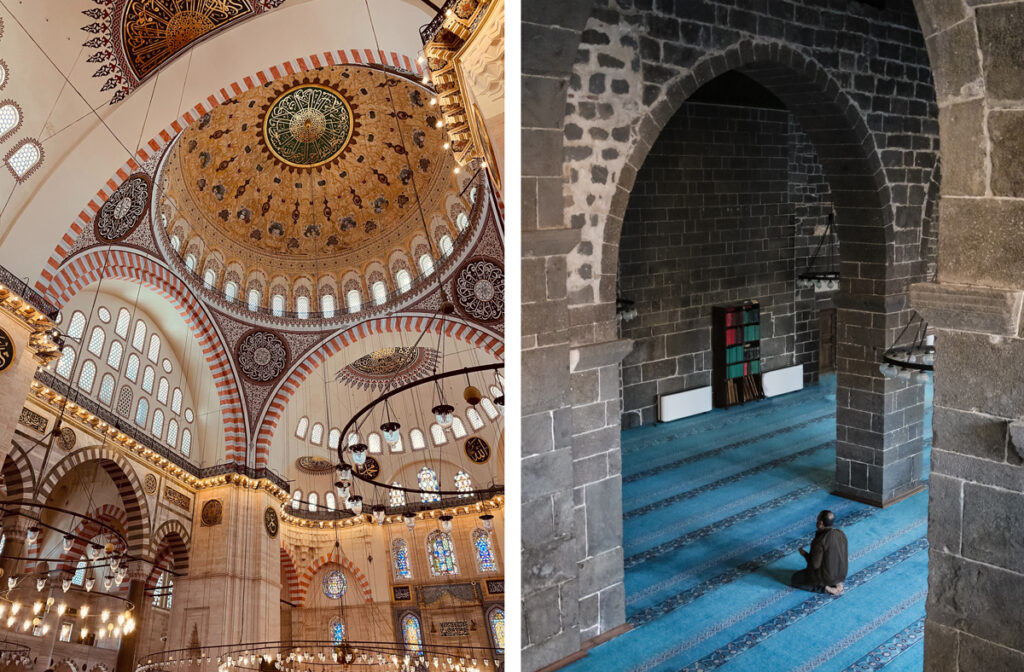
On the right, the Diyarbakır mosque in Istanbul. Photo by Ahmed Yusuf on pexels.
Since the current mosques are considered community and aggregation centers, the sacred building is part of a complex in which there is often a library, a meeting room, the Himam apartment and offices.
JEWISH SYNAGOGUE
The formal characteristics of the synagogues strictly depend on the religious current they represent: the orthodox and the progressive. If in the first case the interior spaces are intended only and exclusively
to the male sex, as women are excluded from worship, in the progressive case the prayer area is designed for both sexes, who in any case must be separated and have no possibility of communication.
The building must always be positioned along the east-west axis with the faithful facing east and must ensure complete accessibility. Inside there is a space for prayer and a meeting place; the hall of worship includes a section for the rabbi which is located in a higher position than the area hosting the faithful. In this area are located the tribune, called bimah, equipped with a pulpit, a lectern for the preacher and two seats for the rabbi and the cantor, the candelabrum or menorah and the sacred cabinet with the scrolls of the law, also called aron.
If the sacred building boasts considerable dimensions, inside the seats for the faithful consist of tiers aimed at ensuring a good view of the cult. The seats are equipped with a lectern and are positioned in front of the grandstand.
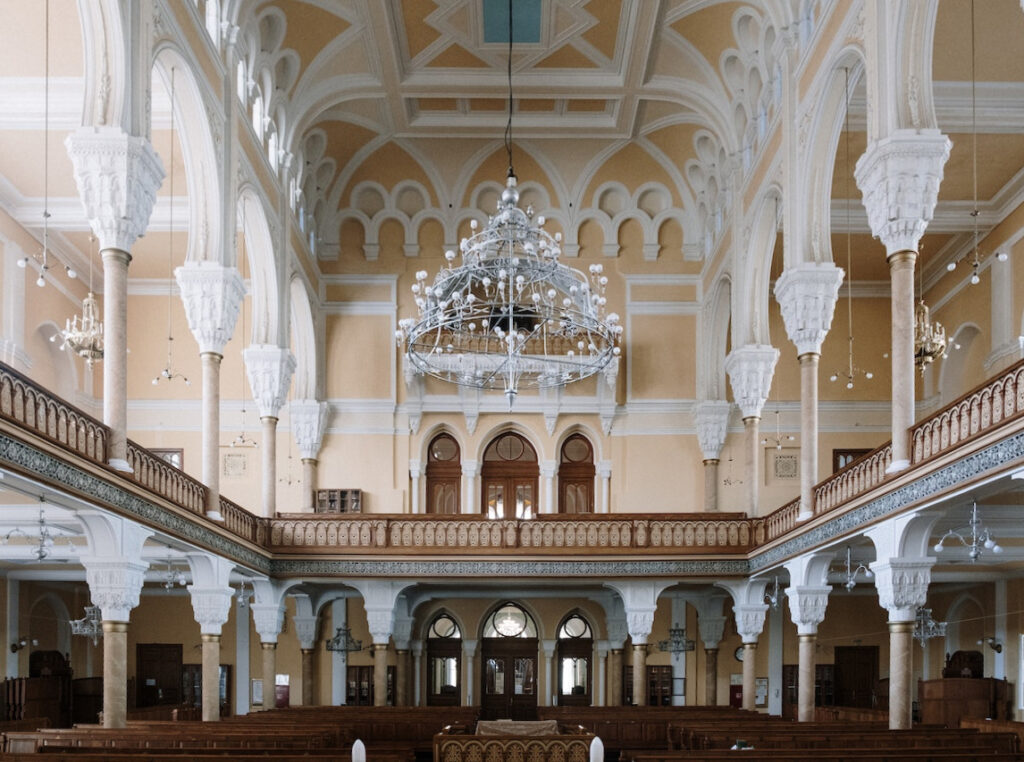
An important aspect of the design of the synagogues is the lighting and heating of the interiors as the ritual often lasts beyond sunset. In fact, in order to ensure optimal thermal and visual comfort, it will be good to provide adequate lamps and air conditioning systems. Often, the synagogue is part of a community complex full of services such as libraries, cultural archives, schools and spaces
meeting place. As in the aforementioned cases, therefore, it is a symbol of the collective life of a specific community.
To view the drawings of the famous Cymbalista Synagogue by Mario Botta click here
Evolution and change in the design of sacred buildings
The previous excursus on the architecture of sacred places relating to the main monotheisms aims to provide an overall picture of the issue. But today, what has changed in design compared to the past?
If we consider the specific case of modern churches, some observations need to be made. It is in fact essential to point out how the approach to the design of these sacred places has changed and how a slow and progressive revolution has taken place on a formal level.
The first aspect concerns the building envelope: if it was once a characterizing element, with a high symbolic value, today it takes off this function, becoming in some cases, an expression of the place where it is located or free interpretation of the architect. The solid-void relationship also changes since, for example, Gothic sacred architecture was distinguished by the few and small openings that guaranteed dark and mysterious interior spaces. Today, however, sometimes the windows are exceeded.
As for the layout of the church, it used to be in the form of a Greek or Latin cross. Current buildings often do not have this planimetric conformation even if the cross is always present behind the altar or in the iconographic program. In the interior spaces the apse was and still is facing east, however if once the celebrant had his back to the faithful, today he addresses them directly. Finally, the rich and ancient decorations leave room for more bare and minimal environments.
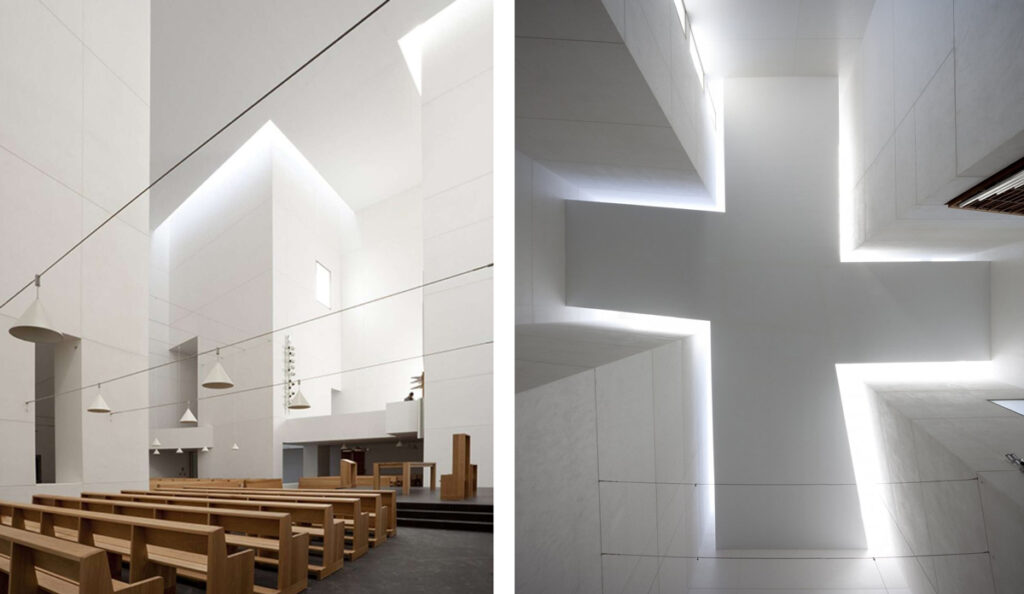
The Iglesia de Iesu by Rafael Moneo is a concrete representation of how the cross layout has been revisited in a modern key and how the Christian symbol permeates the entire building (See the dwg drawings)
There are also some elements that should be observed during the planning process, in order to guarantee a pleasant and safe experience for the faithful. Let’s see them below:
Accessibility
It is essential to ensure complete accessibility for all, through the elimination of architectural barriers and the inclusion of appropriate external ramps. In addition, it is good to provide non-slip flooring and ensure the absence of obstacles for free movement, in order to ensure adequate pedestrian and vehicular traffic. Finally, the presence of standard and disabled parking spaces is mandatory, in proportional numbers with respect to the former.
Safety
Although today the Italian legislation on fire prevention does not impose obligations in the case of sacred places, it is of fundamental importance to indicate the emergency exits and to size the accesses and internal spaces according to the forecasts of user flows.
Thermo-acoustic comfort
In order to ensure optimal acoustic comfort, the building must be designed to ensure the amplification of the sound and at the same time to contain it, in order to avoid unpleasant noises. For this purpose, adequate acoustic diffusion systems and loudspeakers distributed throughout the interior must be present. Also from the point of view of air conditioning it is important to ensure the natural exchange of air, thanks to the windows that can be opened and adjusted according to seasonal needs.
Visual comfort
The church must be properly illuminated in all its spaces, in order to minimize the use of artificial light. Often punctual luminaires are placed to recreate particular scenic effects or to give relevance to valuable architectural details.
In conclusion, with the passing of the centuries, the sacred buildings have assumed a variable importance, linked to the socio-political situation of the time, but in any case they are artifacts of great architectural and symbolic value. For this reason, the design of places of worship presupposes a particular sensitivity to places, social needs and the peculiarities of a specific religion that must be respected and celebrated. It is necessary to keep up with the times, reinterpret tradition in full respect of its core values and ensure the relevance that a context where the sacred unites with the profane deserves.
Cover photo: Brett Sayles on pexels



























































